Apr 13
Posted: under Activities, photography, Plantlife, Water, Weather, Wildlife.
Tags: Activities, beauty, drought, native plants, photography April 13th, 2013
It was a dry fall, after a dry summer, and a dry winter followed the dry fall. Other places got rain–sometimes nearby–but we had none for months. March brought a little–April has brought a little–and now we have some flowers. The bluebonnets may be only 4-5 inches tall, instead of knee-high, but they’re there–in a […] [...more]
It was a dry fall, after a dry summer, and a dry winter followed the dry fall. Other places got rain–sometimes nearby–but we had none for months. March brought a little–April has brought a little–and now we have some flowers.
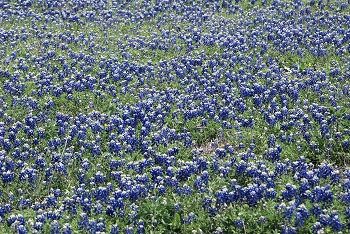
The bluebonnets may be only 4-5 inches tall, instead of knee-high, but they’re there–in a few places–and should be able to make seed for another year. We had more through most of the dry winter, but many finally just died–or were eaten, since they were the only green thing out there.
Read the rest of this entry »

Mar 18
Posted: under Climate Change, Plantlife, Water.
Tags: drought, native plants, natural water March 18th, 2013
I mentioned on Twitter that more trees had failed to leaf out this spring, victims of the long drought which not only did not provide them enough water to survive, but prevented us from having any supplemental water to give them. Someone suggested what seemed reasonable–why not plant trees from the next climate zone (or […] [...more]
I mentioned on Twitter that more trees had failed to leaf out this spring, victims of the long drought which not only did not provide them enough water to survive, but prevented us from having any supplemental water to give them. Someone suggested what seemed reasonable–why not plant trees from the next climate zone (or two) to the south of us. I realized then that the traditional “planting zone/climate zone” concept had taken hold to such an extent that the complexity of keeping anything alive through a rapid change of climate wasn’t being talked about.
Read the rest of this entry »

Oct 15
Posted: under Climate Change, photography, Wildlife.
Tags: beauty, butterflies, drought, photography October 15th, 2011
Monarchs nectaring on Gayfeather (Liatris sp.) [...more]
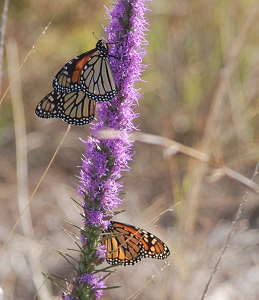
Monarchs nectaring on Gayfeather (Liatris sp.)
Read the rest of this entry »

Aug 23
Posted: under Climate Change, Mortality, photography, Plantlife, Water, Wildlife.
Tags: Activities, climate, drought, photography August 23rd, 2011
Roughleaf dogwood & oak thicket in August 2011 East margin of creek woods–August 2011-leaves turning & dropping Cactus Flat: even the prickly pear is drying out [...more]
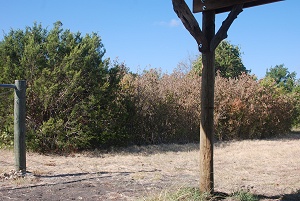 Roughleaf dogwood & oak thicket in August 2011
Roughleaf dogwood & oak thicket in August 2011
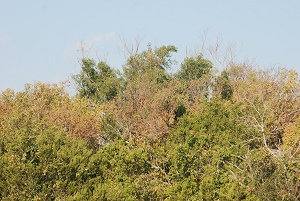 East margin of creek woods–August 2011-leaves turning & dropping
East margin of creek woods–August 2011-leaves turning & dropping
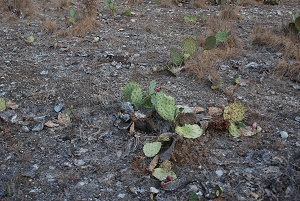 Cactus Flat: even the prickly pear is drying out
Cactus Flat: even the prickly pear is drying out
Read the rest of this entry »

Aug 13
Posted: under Climate Change.
Tags: climate, drought, prairie restoration August 13th, 2009
Since habitat management is part of wildlife management, restoration of degraded or poor habitat is part of our job as wildlife managers. The basic concepts were laid down years ago…but the devil’s in the details, as usual. The July 31, 2009 Science had an entire section on restoration ecology, with examples drawn from around the […] [...more]
Since habitat management is part of wildlife management, restoration of degraded or poor habitat is part of our job as wildlife managers. The basic concepts were laid down years ago…but the devil’s in the details, as usual. The July 31, 2009 Science had an entire section on restoration ecology, with examples drawn from around the world showing the benefits, costs, and difficulties in this field. Especially with the advent of global warming.
Read the rest of this entry »

Jul 06
Posted: under Land, photography, Weather.
Tags: drought, insect, native plants, photography July 6th, 2009
The near meadow, July 4th…another day of record high temperatures and clear skies with a good strong SW wind. [...more]
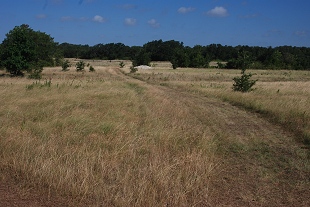
The near meadow, July 4th…another day of record high temperatures and clear skies with a good strong SW wind.
Read the rest of this entry »

Mar 13
Posted: under Water, Weather.
Tags: drought, rain, Weather March 13th, 2009
We hit the jackpot this time. Before dark today, Richard recorded a storm total (over three days ) of 4 inches at Owl Pavilion, 3.7 at Fox Pavilion. The two house gauges, one north of our house and one west of the other house, were measured at roughly noon, both over 3 inches. This is […] [...more]
We hit the jackpot this time. Before dark today, Richard recorded a storm total (over three days ) of 4 inches at Owl Pavilion, 3.7 at Fox Pavilion. The two house gauges, one north of our house and one west of the other house, were measured at roughly noon, both over 3 inches.
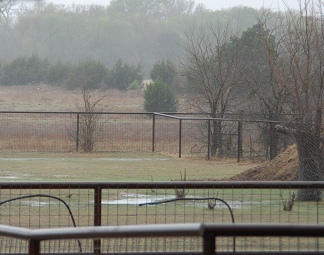
This is a shot from the end of the front porch, across the barn pen fence, into the south horse lot, about four Friday afternoon. Puddles!!! Green!!! (that field was gray-tan three days ago. Our grass is ambitious.)
Read the rest of this entry »

Feb 13
Posted: under Activities, photography, Plantlife.
Tags: Activities, drought, photography February 13th, 2009
Even in a dry year, spring comes early to central Texas. I’m recovering from pneumonia so can’t get out to the full 80 acres, but here are some pictures from around the house. (I need to plant some elbowbush up by the house, as it’s one of the very earliest.) Rusty blackhaw viburnum is one […] [...more]
Even in a dry year, spring comes early to central Texas. I’m recovering from pneumonia so can’t get out to the full 80 acres, but here are some pictures from around the house. (I need to plant some elbowbush up by the house, as it’s one of the very earliest.)
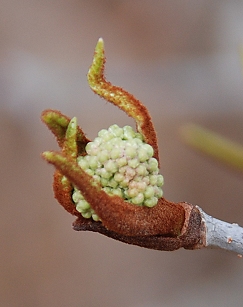
Rusty Blackhaw Viburnum bud
Rusty blackhaw viburnum is one of the most beautiful of the native shrubs, but it’s routinely scraped off by developers as “brush”. Here, the buds are just opening to show the bud-cluster that will be a puffball of pure white within a week. Easy to see why it acquired the name “rusty.” It’s a valuable plant for wildlife, producing tasty blue berries for birds–and nectar for the early butterflies and moths.
Read the rest of this entry »

Dec 08
Posted: under Water, Weather.
Tags: drought December 8th, 2008
Our area is at least sixteen inches below average annual rainfall this year–that’s means we’ve had less than half the average. The “at least” is because what rain we’ve had has been spotty–one place might get four inches and another none, from the same weather system. In addition to the lack of rainfall, aquifers and […] [...more]
Our area is at least sixteen inches below average annual rainfall this year–that’s means we’ve had less than half the average. The “at least” is because what rain we’ve had has been spotty–one place might get four inches and another none, from the same weather system.
In addition to the lack of rainfall, aquifers and reservoirs both are sinking. One of our town’s four wells isn’t producing at all, and the other three are pumping less than normal. A development-friendly county government has supported rapid growth, both residential and commercial, with the predictable (but not to them) growth in demand for water…hence many new wells, all tapping the same resource…shallow wells tapping the groundwater that used to supply springs and small creeks in dry years, and deep wells (to Trinity Sands, the main deep aquifer) for “permanent” water. Creeks and springs–even one river–have dried up completely in the past year.
From the land manager’s perspective, rainfall is THE water resource in this part of the world. We have two “rain barns” to collect and store rainwater (and are working on another–trusses for its roof are finished and being painted.) This stored water provides permanent (we hope) water for wildlife at three different sites and each site is optimized for a different use.
Wildlife (and re-introduction of native plants to improve natural food supplies and habitat) must have reliable water. This year, it was all we could do to keep the wildlife supply going. We lost approximately 90% (maybe more–we’ll know next spring) of the past two years’ worth of plantings because we could not provide enough water…what we could provide, we allocated to a few of the plantings easiest to reach with a bucket.
But if it doesn’t rain…there’s nothing to collect. I designed the collection area/storage capacity for a little below the previously recorded worst-case–ten inches a year–but that’s where we are right now.
The bright spot in this is the response of the original (and re-introduced) natives that didn’t croak. The deep-rooted tallgrass dominants stayed green: big bluestem, switchgrass, Indiangrass, little bluestem, even eastern gama (the water lover of the bunch) are all fine (so far.) Up on the dryest area (a rocky knoll with very thin soil, if any) some didn’t make it–even agarita, which normally grows out of rock anyway–but some did. We have more two-leaved senna and partridge pea than before. We have a new odd milkweed (the experts are still arguing over it.) The Mirabilis alba and Pitcher Sage have both spread this year, and the Maximilian Sunflower, though less than half the height in an average year, has continued to spread sideways in its clumps.









